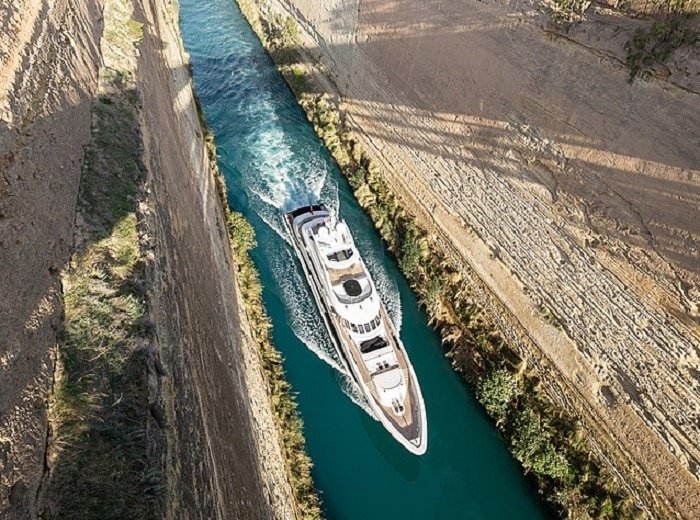While the world was focusing on the drama surrounding the closure of the Suez Canal in late May, another maritime crisis is unfolding — almost unnoticed — on the northern shore of the Mediterranean.
The Corinth Canal, one of the most important infrastructure works of modern Greece which completely revolutionized its maritime activity, has remained closed to maritime traffic since January 2021.
The Canal, unfortunately, suffered damage due to landslides at that time, making maritime passage dangerous. Repair work is currently underway, but there is no clear timetable as to when it will be completed.
According to the studies carried out so far by the Ministry of Infrastructure & Transport, moisture and erosion caused the loss of the stone piers that supported and protected the ground from falling into the canal.
The preliminary work on the studies is expected to be completed in September. Then the construction for the project will go up for bid, and the preliminary works on the sides of the Canal will begin subsequently.
As Greece is preparing to open to tourism this summer, thousands of visitors who pass through from the Ionian to the Aegean Seas on yachts and cruise ships will either have to cancel or take the long and much costlier route around the Peloponnesian peninsula.
In addition, of course, commercial shipping in Greece is already suffering as the cost of transporting goods and fuel is increasing. Economists fear that this may result in medium to long-term price increases.
The future of the operator of the Canal and its employees is also at stake, as revenues have now completely dried up.
Last Saturday, Greek Prime Minister Kyriakos Mitsotakis visited the Canal, where he was briefed on its repair plan.
Mitsotakis said full repairs are necessary to ensure the safe passage of ships through the channel.
“It is a very important project and we should not forget that it was built in the 19th century. The time has come now, in the 21th century, the time has come for the necessary interventions,” he said, adding that repairs will cost nine million euros.
Corinth canal changed maritime routes
The Corinth Canal was opened for use on July 25, 1893.
Also known as the Isthmus of Corinth, the canal connects the Ionian and the Aegean making the passage of cargo and passenger ships between the two seas much quicker.
Construction works started in 1882 and the canal was officially opened by then Prime Minister Sotirios Sotiropoulos, but it was envisioned and completed by his predecessor Harilaos Trikoupis, whose term had ended just two months before that date.
Before the canal was built, ships from the Ionian Sea with the destination of Athens or the Aegean islands had to go all the way around the Peloponnesian peninsula and vice versa.
After 1893, cargo and passenger ships would only have to cross the Corinth Canal and reach their destination much more quickly.
The word “isthmus,” which comes from the Ancient Greek word for “neck,” refers to the narrowness of the land.
Ancient Greeks attempted to build a canal
The idea for a shortcut to save boats from the perilous journey of sailing all the way around the Peloponnese was long considered by the Ancient Greeks.
The first attempt to build a canal there was carried out by the tyrant Periander in the 7th century BC.
He abandoned the project owing to technical difficulties, and instead constructed a simpler and less-costly overland stone road named the Diolkos, as a portage road. Parts of the Diolkos still exist today next to the modern canal.
When the Romans took control of Greece, a number of different solutions were tried as a way to enable passage from the Ionian to the Aegean. Julius Caesar himself foresaw the advantages of a link for his newly-built Colonia Laus Iulia Corinthiensis.
By the reign of Tiberius, engineers tried to excavate a canal but were unable to succeed due to a lack of powerful enough equipment.
Instead, they used an ancient Egyptian device: boats were rolled across the isthmus on logs, as the Egyptians had rolled blocks of granite to make their pyramids.
In 67 AD, the Roman emperor Nero ordered 6,000 slaves to dig a canal with spades. Historian Flavius Josephus wrote that the 6,000 slaves were Jewish pirates, taken captive by Vespasian during the Jewish wars.
According to Pliny the Elder, the work advanced four stadia (about 0.8 kilometers). The following year Nero died, and his successor Galba abandoned the project as being too expensive.
In the modern era, the idea was first seriously proposed in 1830, soon after Greece’s independence from the Ottoman Empire.
The Greek statesman Ioannis Kapodistrias hired a French engineer to put together a realistic project — which ended up with an estimated steep price of 40 million gold francs — making Greece abandon the costly project once again.
Suez Canal served as inspiration for the Corinth canal
Soon after, inspired by the construction of the Suez Canal, Prime Minister Thrasyvoulos Zaimis signed a law in 1870 that authorized the engineering project for the Corinth Canal.
A French company oversaw the project that resulted in the construction phase starting and soon after ending — again due to cost issues.
The dream of the Corinth Canal would finally become a reality when in 1881, the Société Internationale du Canal Maritime de Corinthe was commissioned to construct the canal and to operate it for the next 99 years.
Construction began in April 1882; however, eight years later, Greece ran out of money. This time, a Greek company stepped in and the canal was finally completed in July of 1893.
To the west of the Isthmus is the Gulf of Corinth, to the east the Saronic Gulf. Since 1893 the Corinth Canal has run through the 6.3 km (3.9 miles) wide isthmus, effectively making the Peloponnesian Peninsula an island.
Today, two road bridges, two railway bridges, and two submersible bridges at both ends of the canal connect the mainland side of the isthmus with the Peloponnesian side. In addition, a military emergency bridge is located at the west end of the canal.
Source: Greece’s Suez Crisis: Corinth Canal Closed for More than Three Months

